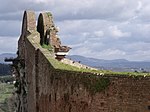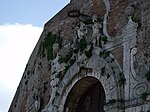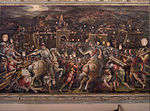Porta Camollia
The Porta Camollia is a city gate in Siena and part of the city walls of Siena .
location
The city gate Porta Camollia is located at the northern end of the historic city center of Siena at the end of Via Camollia. The street that continues after the city gate is called Via Vittorio Emanuele II, named after Victor Emanuel II , and leads to Florence . The historical route led over the Via Chiantigiana (today's Strada Provinciale SP 222). In addition, the city gate is located on the Via Francigena and the historic route of the Via Cassia . The leading from the gate to the west road is the by Blaise de Montesquiou called Via Biagio di Montluc and performs at Arco di Fontegiusta past the fortress Santa Barbera(Fortezza Medicea), to the east the Viale Don Giovanni Minzoni leads to the former city gate Porta San Lorenzo , today called Le lupe (The Women Wolves).
The city gate is located in the third third of the city Terzo di Camollia in the Contrada Istrice (porcupine) and is located in the city wall between the Porta Ovile and the fortress Santa Barbara.
history
The name was first mentioned Camollia in July 1028 in a document of the Bishop of Florence for the Borgo Camollia lying church Chiesa di San Pietro alla Magione . The name comes from a women's shelter or convent (Casa Mulierum) that no longer exists today, which over time became Ca 'mulierum and then Camollia . This borgo was incorporated into the defensive ring in the middle of the 12th century when the city wall was expanded. For this purpose, new city gates such as the Porta di Bartolomeo Guerra , the Porta Campansi (both no longer exist today) and the Porta Camollia were built in northern Siena . The defense complex, called Castellaccia di Camollia , was built in the 13th century on the Prato di Camollia field and stretched north from Porta Camollia over Torrazzo di mezzo (central tower, also called Porta Vetus , no longer existing today) to the north to Antiporto di Camollia (also called Portone dipinto , front gate, still present today) and the gate Porta Franca that is still in front of it . The reverse postage was created after the battle of Montaperti between 1262 and 1270.
In 1526, Siena had to defend itself against a siege by the Fiorentines and Clement VII . The siege was ended by the military victory of the Senese in the so-called Battaglia di Camollia (Battle of Camollia) on July 25, 1526. As a result of the threat to the Camollia fortresses built Baldassare Peruzzi as Architetto della Repubblica in 1530 the Bastion Fortino delle Donne Senesi (also Fortino di Pescaia called) and strengthened the fortifications.
In 1553, the grounds outside the Castellaccia were further strengthened by the Architetto della Repubblica di Siena Giovanni Battista Pelori (1483–1558) and the French military leader Paul de la Barthe, seigneur de Thermes , and equipped with three additional fortress towers. The connecting trench to San Prospero to the southern Cittadella could not be completed in time. The siege of Siena from 1554 to the abandonment of the city in April 1555 also had its starting point at Porta Camollia. The Fiorentine besiegers of Cosimo I de 'Medici with the support of Spanish troops took the defensive complex of Castellaccia di Camollia on January 26, 1554 under the leadership of Gian Giacomo Medici and kept the base for the units in the immediate vicinity between the church of Santa Patronilla and the Palazzo Diovoli . After the defeat of the Senese republic and the dictated peace treaty, the besiegers moved through the Porta Camollia, while the defenders moved through the Porta Nuova to Montalcino . In the conflict with Florence, Porta Camollia suffered the most of all the city gates, although it was the most fortified. Due to the severe damage to the main gate, another, smaller, archway was inserted into the walls about 10 m further east. This was bricked up again after the new gate was built.
Today's city gate was built in 1604 by Alessandro Casolani and the sculptor Domenico Cafaggi, also known as Domenico Capo. The decisions to rebuild the gate were made by the Balìa (Senese government) in the summer of 1603.
The two smaller side entrances were created in the course of the restoration in 1930/31, whereby the right archway, seen from the outside, was created as pedestrian access in 1930 and the customs house was demolished for this purpose. The left, eastern archway was built in 1931.
Inscriptions and works of art
The outside contains the inscription COR MAGIS TIBI SENA PANDIT in the stone archway , which is a dedication to Ferdinando I de 'Medici . Above is the Medici coat of arms with the dedication Ferdinando Med. / Mag. Duci Etr. III / SPQS The two works as well as the other decorations are made of travertine and come from the sculptor Domenico Cafaggi. The IHS seal of St. Bernard of Siena is on the inside of the gate .
Porta Camollia in art
The Porta Camollia has been depicted several times in art.
-
Biccherna panels (household books of the city of Siena), Siena State Archives in the Palazzo Piccolomini.
- La battaglia di Camollia , painted by Giovanni di Lorenzo Cini in 1527.
- L'ingresso di Cosimo I. 1561.
- Giovanni di Lorenzo Cini: L'Immacolata protegge Siena durante la battaglia di Camollia , Chiesa di San Martino, Siena, written in 1528.
- Rutilio Manetti : La città di Siena , also called Veduta di Siena , Siena State Archives in the Palazzo Piccolomini, created around 1610.
- Pinturicchio : Enea Silvio, Vescovo di Siena, presenta Eleonora d'Aragona all'imperatore Federico III. Libreria Piccolomini, Siena Cathedral , fresco, created around 1502. The meeting itself took place on February 24, 1452 between Friedrich III. and Eleonore Helena of Portugal .
- Pinturicchio: San Bernardino giovinetto in preghiera davanti all'immagine dellaVergine dipinta sulla Porta di Camollia , Cappella Bufalini ( Chapel of St. Bernard of Siena ), Santa Maria in Aracoeli , Rome , fresco, 1486.
- Ventura Salimbeni : San Bernardino giovinetto in preghiera davanti alla Vergine di Porta Camollia , Sala del Capitano (Aula Consiliare), Palazzo Pubblico , Siena, fresco, created in 1598.
- Francesco Vanni : Il Beato Ambrogio Sansedoni implora per la città di Siena , Chiesa di Santa Maria in Portico a Fontegiusta, created in 1589.
- Giorgio Vasari : La presa del Forte presso Porta Camollia di Siena , Sala del Cinquecento, Palazzo Vecchio , Florence, fresco, created 1567–1571.
photos
Giorgio Vasari : La presa del Forte presso Porta Camollia di Siena , fresco in the Palazzo Vecchio in Florence
literature
- Contrada Sovrana dell'Istrice (ed.): Porta Camollia. Because baluardo di difesa a simbolo di accoglienza. Siena 2004, ISBN 88-89184-07-8 .
- Ettore Pellegrini: Fortificare con arte. Mura, porte e fortezze di Siena nella Storia. Betti Editrice, Siena 2012, ISBN 978-88-7576-228-5 .
- Simon Pepper / Nicholas Adams: Armi da fuoco e fortificazioni. Architettura militare e guerre d'assedio nella Siena del XVI secolo. Nuova Immagine Edizioni, Siena 1995, ISBN 88-7145-068-X .
- Emanuele Repetti: CAMOLLIA, o CAMULLIA. In: Dizionario Geografico Fisico Storico della Toscana. (1833–1846), online edition of the University of Siena (PDF, Italian)
- Piero Torriti: Tutta Siena. Contrada per Contrada. Edizioni Bonechi, Florence 2004, ISBN 88-7204-456-1 , p. 283 ff.
- Touring Club Italiano : Toscana. Milan 2003, ISBN 88-365-2767-1 , p. 576 f.
Web links
- Official website of the city of Siena for Porta Camollia
- Augusto Codogno: CAMOLLIA: “COR MAGIS TIBI SENA PANDIT”. Il toponimo appare in “Villa que dicitur Camullja iuxta strata romea”. In: ilcittadinoonline from January 31, 2014.
Individual evidence
- ↑ a b Torriti
- ↑ a b c d e Ettore Pellegrini: Fortificare con arte. Mura, porte e fortezze di Siena nella Storia.
- ↑ a b c Stefano Moscadelli: Forza Accoglienza Ornamento. Riflessioni su porta Camollia In: Porta Camollia. Because baluardo di difesa a simbolo di accoglienza.
- ^ Alberto Fiorini: Le mura e le porte della cerchia esterno. Le Porte di Camollia: Antiporto, Torrazzo e Porta Franca. In: Ettore Pellegrini: Fortificare con arte. Mura, porte e fortezze di Siena nella Storia.
- ^ Fausto Landi: Gli ultimi anni della Repubblica di Siena 1525–1555. Edizioni Cantagalli, Siena 1994, p. 11 ff.
- ↑ Pelòri, Giovanni Battista at Enciclopedie on line Treccani , accessed on January 16, 2014 (Italian)
- ↑ Simon Pepper / Nicholas Adams: Armi da fuoco e fortificazioni. Architettura militare e guerre d'assedio nella Siena del XVI secolo.
- ↑ a b Ettore Pellegrini: Porta Camollia nel Cinquecento. Centralita storica ed iconografia di una struttura fortificata senese. In: Porta Camollia. Because baluardo di difesa a simbolo di accoglienza.
- ^ Fausto Landi: Gli ultimi anni della Repubblica di Siena 1525–1555. Edizioni Cantagalli, Siena 1994, p. 132 ff.
- ↑ a b c Cecilia Papi: Siena: A chi apri il tuo cuore? In: Porta Camollia. Because baluardo di difesa a simbolo di accoglienza.
- ↑ Alberto Cornice: Cafaggi, Domenico, ditto Capo. In: Dizionario Biografico degli Italiani - Volume 16 (1973), online version , accessed on February 16, 2014 (Italian)
- ↑ Mauro Mussolin: Il culto dell'Immacolata Concezionenella cultura senese del Rinascimento. Tradizione e iconografia. In: Mario Lorenzoni, Roberto Guerrini (Ed.): Forte Fortuna. Religiosità e arte nella cultura senese dalle origini all'umanesimo di Pio II ai restauri del XIX secolo. Quaderni dell'Opera 7-8-9, Opera della Metropolitana, Siena 2006, p. 225 ( online version at academia.edu , accessed on March 17, 2014, Italian)
- ↑ Archive of the official website of the city of Siena for the painting San Bernardino giovinetto in preghiera davanti alla Vergine di Porta Camollia in the Palazzo Pubblico ( Memento of the original from March 18, 2014 in the Internet Archive ) Info: The archive link was inserted automatically and has not yet been checked. Please check the original and archive link according to the instructions and then remove this notice. , accessed on March 17, 2014 (Italian)
- ↑ culturaitalia.it on the painting San Bernardino giovinetto in preghiera davanti alla Vergine di Porta Camollia in the Palazzo Pubblico (with ill.), Accessed on March 17, 2014 (Italian)
- ↑ Giorgio Vasari: La presa del Forte presso Porta Camollia di Siena ( Memento of the original from March 11, 2014 in the Internet Archive ) Info: The archive link was inserted automatically and has not yet been checked. Please check the original and archive link according to the instructions and then remove this notice. , Mediateca Medicea Palazzo Medici Riccardi, accessed on March 10, 2014 (Italian)
Coordinates: 43 ° 19 ′ 39.6 ″ N , 11 ° 19 ′ 31.4 ″ E





